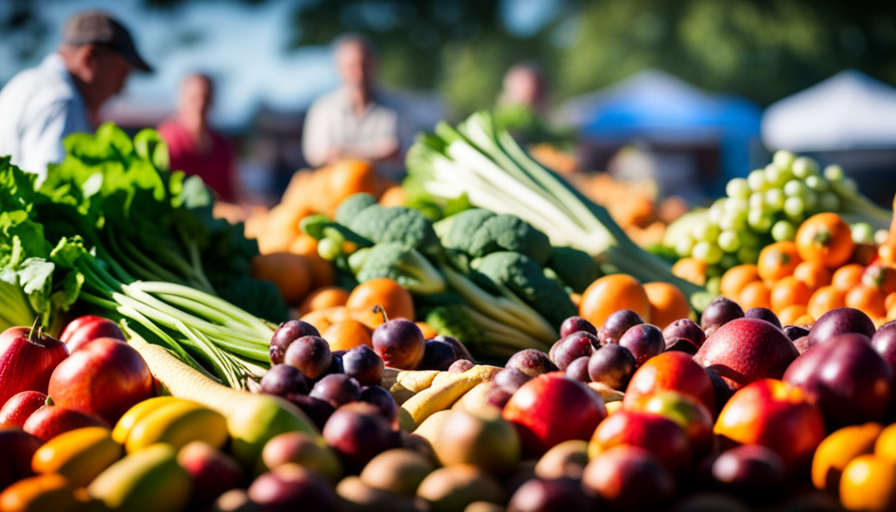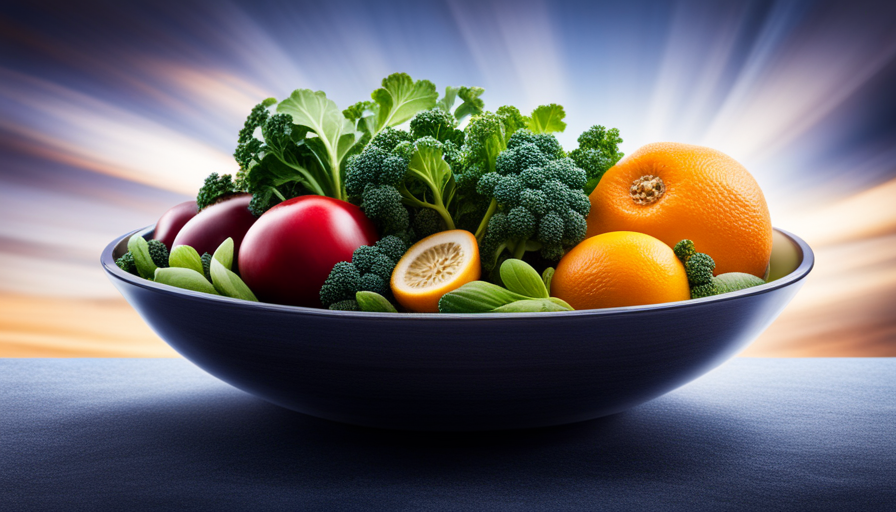Embarking on a raw food diet is like immersing yourself in a colorful array of flavors and nutrients, where every bite nourishes your body and excites your taste buds. This way of eating focuses on consuming foods in their natural state, such as fruits, vegetables, nuts, and seeds, without any cooking or processing involved.
By embracing the raw food diet, you are immersing yourself in a world of health benefits that can transform your well-being. From increased energy levels and improved digestion to enhanced immunity and weight management, the advantages are vast.
However, transitioning to this lifestyle may seem daunting at first. Fear not, as this article will guide you through the process of following a raw food diet seamlessly. You will learn how to obtain essential nutrients, incorporate raw fruits and vegetables into your meals, discover delicious raw food recipes, and stay balanced on this extraordinary journey.
Get ready to embark on a path towards optimal health and vitality.
Key Takeaways
- Transitioning to a raw food diet can be done gradually by incorporating more raw fruits, vegetables, and nuts into meals.
- Educating yourself about the benefits and challenges of a raw food diet is important.
- Meal planning is essential to ensure you get all the necessary nutrients on a raw food diet.
- Staying balanced on a raw food diet involves finding support and maintaining variety in your meals.
Understanding the Raw Food Diet
If you want to understand the raw food diet, you’re in for an exciting journey of discovering the incredible benefits it can bring to your health and well-being! There are many misconceptions surrounding raw food, so let’s debunk some common raw food myths.
Firstly, one of the biggest misconceptions is that a raw food diet consists solely of fruits and vegetables. While these foods are definitely a major part of the diet, it also includes nuts, seeds, sprouted grains, and even fermented foods. The goal is to consume foods in their most natural and unprocessed state, as cooking can destroy some of the nutrients and enzymes present in raw foods.
Another common myth is that a raw food diet lacks essential nutrients. However, research has shown that raw foodists can obtain all the necessary nutrients, including protein, calcium, and iron, from a well-planned raw food diet. It’s important to ensure a variety of foods are included in the diet to meet nutritional needs.
Additionally, many people believe that a raw food diet is difficult to follow and requires a lot of time and effort. While it does require some planning and preparation, there are plenty of delicious and simple raw food recipes available. With a bit of creativity, you can enjoy a wide range of flavorful meals that are also nutritious.
Understanding the raw food diet involves dispelling common misconceptions and myths. By incorporating a variety of raw foods into your diet, you can enjoy the numerous health benefits that come with this way of eating.
Benefits of a Raw Food Diet
One of the advantages of adopting a raw food lifestyle is the potential for increased energy and vitality. When you consume raw fruits, vegetables, nuts, and seeds, you’re providing your body with a wealth of nutrients that can fuel your daily activities. Raw foods are rich in enzymes, which help your body digest food more efficiently and increase your energy levels.
Additionally, raw foods are typically less processed and contain fewer additives, which can further contribute to increased vitality.
Another benefit of a raw food diet is its potential for weight loss. Raw foods are generally low in calories and high in fiber, which can help you feel fuller for longer. By incorporating more raw foods into your diet, you can reduce your calorie intake and potentially shed excess pounds. Additionally, raw foods are nutrient-dense, meaning you can consume smaller portions while still meeting your nutritional needs.
While a raw food diet can offer numerous health benefits, it’s essential to be aware of potential health risks. Raw foods can be more susceptible to contamination, so it’s crucial to thoroughly wash and handle them safely. It’s also important to ensure you’re getting a balanced diet by incorporating a variety of raw foods and consulting with a healthcare professional or registered dietitian.
Adopting a raw food lifestyle can provide increased energy and vitality, as well as potential weight loss benefits. However, it’s important to be mindful of health risks and ensure a balanced diet.
Transitioning to a Raw Food Diet
Making the switch to a raw food lifestyle can be a transformative journey that invigorates your mind, body, and soul. If you’re considering transitioning to a raw food diet, here are some helpful tips to guide you along the way:
Start slowly: Transitioning to a raw food diet doesn’t have to happen overnight. Begin by incorporating more raw fruits, vegetables, and nuts into your daily meals and gradually increase the amount over time. This gradual approach will make the transition easier and more sustainable.
Educate yourself: There are many misconceptions surrounding raw food diets, so it’s important to do your research and separate fact from fiction. Learn about the nutritional benefits of raw foods, how to properly prepare them, and the potential challenges you may face during the transition.
Get creative in the kitchen: One of the keys to successfully transitioning to a raw food diet is to experiment with different recipes and flavors. Explore new fruits, vegetables, and herbs, and try out different preparation methods like juicing, blending, and dehydrating. This will help keep your meals interesting and enjoyable.
Transitioning to a raw food diet requires dedication and a willingness to explore new tastes and textures. By following these tips and dispelling common misconceptions, you can embark on a journey that will nourish your body and revitalize your overall well-being.
Essential Nutrients in Raw Foods
Embark on a journey through the vibrant world of raw foods and unlock the hidden treasures of essential nutrients that’ll nourish your body and revitalize your overall well-being. A raw food diet isn’t only beneficial for weight loss but also for skin health.
Raw foods are rich in vitamins, minerals, and antioxidants that support healthy skin and promote a youthful glow. One of the key benefits of a raw food diet for weight loss is its low calorie density. Raw fruits and vegetables are naturally low in calories and high in fiber, which helps you feel fuller for longer. This can aid in weight loss by reducing your overall calorie intake.
Additionally, raw foods are packed with nutrients that’re essential for maintaining healthy skin. Fruits like berries and citrus fruits are high in vitamin C, which’s crucial for collagen production and skin repair. Leafy greens are rich in antioxidants like beta-carotene and vitamin E, which can protect your skin from damage caused by free radicals.
By incorporating a variety of raw fruits, vegetables, nuts, and seeds into your diet, you can reap the benefits of essential nutrients that support weight loss and promote healthy skin. Remember to consult with a healthcare professional or registered dietitian before making any significant changes to your diet.
Incorporating Raw Fruits and Vegetables
Explore the vibrant world of raw fruits and vegetables and discover how incorporating them into your daily routine can transform your overall health and well-being.
When following a raw food diet, it’s essential to include a variety of raw fruits and vegetables to obtain all the necessary nutrients.
Raw fruits and vegetables are packed with vitamins, minerals, and antioxidants that can boost your immune system, improve digestion, and increase energy levels. They’re also low in calories and high in fiber, making them an excellent choice for weight management. Incorporating raw fruits and vegetables into your diet can also help reduce the risk of chronic diseases such as heart disease, diabetes, and certain types of cancer.
To get the most out of your raw fruits and vegetables, it’s important to choose organic and locally sourced produce whenever possible. This ensures that you’re getting the highest quality and most nutrient-dense foods. It’s also recommended to eat a variety of colors, as different colors indicate different nutrients. For example, orange fruits and vegetables like carrots and oranges are rich in beta-carotene, which is important for healthy skin and eyes.
Incorporating raw fruits and vegetables into your daily routine can be as simple as adding a side salad to your meals, snacking on raw fruits throughout the day, or making a refreshing green smoothie for breakfast. Experiment with different combinations and flavors to keep things interesting and enjoyable. Remember, the key to a successful raw food diet is to listen to your body and eat intuitively.
By following these raw food diet tips and incorporating raw fruits and vegetables into your daily routine, you can experience the numerous benefits of a raw food diet and improve your overall health and well-being.
Preparing Raw Meals and Snacks
To enjoy the vibrant flavors and textures of raw meals and snacks, you can easily whip up colorful salads, blend refreshing smoothies, or assemble creative veggie wraps. Raw food diet meal planning is essential to ensure you get all the necessary nutrients.
When preparing your raw meals and snacks, it’s important to choose a variety of fruits, vegetables, nuts, and seeds to create a well-balanced diet. One of the benefits of a raw food diet is that it retains more nutrients compared to cooked food. Cooking can destroy enzymes and vitamins, so eating raw ensures you get the maximum nutritional value.
To start your raw food journey, invest in a good blender and food processor. These tools will help you create delicious smoothies, dips, and sauces. You can also use a dehydrator to make raw crackers, bread, and snacks.
When it comes to meal planning, focus on incorporating a rainbow of fruits and vegetables. This will not only make your meals visually appealing but also provide a wide range of vitamins, minerals, and antioxidants. Experiment with different flavor combinations and textures to keep your meals interesting. Don’t forget to include plenty of leafy greens, as they’re packed with nutrients and fiber.
Preparing raw meals and snacks is a fun and creative process. By incorporating a variety of fruits, vegetables, nuts, and seeds into your diet, you can enjoy the benefits of a raw food diet while ensuring you meet your nutritional needs. Remember, a raw food diet isn’t about restriction but rather about embracing the natural flavors and goodness of whole foods.
Raw Food Recipes for Beginners
Get ready to tantalize your taste buds with these simple and delicious recipes that’ll introduce you to the world of raw cuisine. Whether you’re looking for a refreshing smoothie or a guilt-free dessert, these raw food recipes for beginners are sure to satisfy your cravings.
-
Raw Food Smoothie Recipes:
- Green Goddess Smoothie: Blend together spinach, banana, almond milk, and a handful of fresh mint leaves for a refreshing and nutritious start to your day.
- Berry Blast Smoothie: Combine mixed berries, coconut water, and a splash of lemon juice for a burst of antioxidants and vitamins.
- Tropical Paradise Smoothie: Blend pineapple, mango, coconut milk, and a squeeze of lime for a taste of the tropics in every sip.
- Chocolate Avocado Smoothie: Mix ripe avocado, cacao powder, almond milk, and a touch of honey for a creamy and indulgent treat.
-
Raw Food Dessert Recipes:
- Raw Chocolate Brownies: Combine dates, nuts, cacao powder, and a pinch of sea salt for a rich and fudgy brownie that’s packed with nutrients.
- Coconut Mango Pudding: Blend ripe mango, coconut milk, and a hint of vanilla for a creamy and tropical dessert.
- Raw Vegan Cheesecake: Create a crust of nuts and dates, then blend cashews, coconut oil, lemon juice, and maple syrup for a velvety smooth cheesecake filling.
- Chia Seed Pudding: Mix chia seeds, almond milk, and your choice of sweetener, then let it set overnight for a healthy and satisfying dessert.
These raw food smoothie and dessert recipes aren’t just delicious, but they also provide you with a plethora of vitamins, minerals, and antioxidants. So grab your blender and get ready to enjoy the benefits of raw cuisine.
Staying Balanced on a Raw Food Diet
Now that you’ve learned some delicious raw food recipes for beginners, let’s explore how to stay balanced on a raw food diet. It’s important to find support while embarking on this new lifestyle. Surround yourself with like-minded individuals, join online communities, or attend raw food meetups for the encouragement and motivation you need to stay on track.
One key aspect of maintaining a raw food diet is to ensure you have a variety of foods in your meals. This ensures that you’re getting a wide range of nutrients and prevents you from getting bored with your food choices. Incorporate a variety of fruits, vegetables, nuts, and seeds into your diet to ensure you’re getting all the essential nutrients your body needs.
Additionally, experiment with different preparation techniques, such as juicing, blending, or dehydrating, to add variety to your meals. Trying new recipes and exploring different flavors will keep your taste buds excited and prevent monotony.
Remember, staying balanced on a raw food diet is all about finding support and maintaining variety. With the right mindset and a little bit of creativity, you can thrive on this nourishing and vibrant way of eating.
Overcoming Challenges and Temptations
Conquering the obstacles and resisting irresistible temptations can be a thrilling adventure on your journey towards embracing a vibrant and nourishing lifestyle. When following a raw food diet, you may encounter cravings for cooked or processed foods. These cravings can be challenging to overcome, but with determination and the right strategies, you can stay on track.
Here are three effective ways to overcome cravings on a raw food diet:
-
Understand the root cause: Cravings often arise from nutrient deficiencies or emotional triggers. By identifying the underlying reason behind your cravings, you can address them more effectively. For example, if you’re craving salty foods, your body may be lacking minerals like sodium or potassium. In that case, incorporating mineral-rich foods like sea vegetables or celery into your diet can help reduce cravings.
-
Find healthy alternatives: Instead of giving in to unhealthy temptations, explore delicious and nutritious raw alternatives. For instance, if you’re craving a sweet treat, try indulging in a juicy fruit salad or a raw dessert made with dates and nuts. Discovering new raw food recipes and experimenting with different flavors can make the transition easier and more enjoyable.
-
Seek support: Surrounding yourself with like-minded individuals who understand and support your raw food journey can be invaluable. Connect with online communities, attend raw food meetups, or find a raw food coach or mentor who can provide guidance and encouragement. Having a strong support system can help you stay motivated and accountable.
By implementing these strategies and finding the support you need, you can overcome cravings and navigate the challenges that may arise while following a raw food diet. Remember, the key is to stay focused on your goals and embrace the incredible benefits that come with this nourishing lifestyle.
Listening to Your Body’s Needs
By tuning into your body’s signals and trusting its wisdom, you can embark on a journey of self-discovery and find the right nourishment for your unique needs.
When following a raw food diet, it’s important to listen to your body and understand its needs. Listening techniques such as mindful eating and intuitive eating can help you develop a deeper connection with your body and make informed choices about the foods you consume.
Mindful eating involves being present in the moment while you eat, paying attention to the flavors, textures, and sensations of each bite. This technique allows you to slow down and fully experience your meals, making it easier to recognize when you’re satisfied and no longer hungry.
Intuitive eating, on the other hand, involves trusting your body’s signals of hunger and fullness. Instead of relying on external cues or strict rules, you learn to listen to your body and eat when you’re hungry and stop when you’re satisfied.
By incorporating these listening techniques into your raw food diet journey, you can develop a greater understanding of your body’s needs and find the right balance of nutrients.
Remember, everyone’s body is different, so what works for one person may not work for another. Trusting your body and listening to its signals will guide you towards the nourishment that best supports your health and well-being.
Frequently Asked Questions
Can I still eat cooked food occasionally while following a raw food diet?
Yes, you can still eat cooked food occasionally while following a raw food diet. It’s all about finding balance. When you choose to have cooked food, opt for healthier alternatives like steaming or baking instead of frying. This can help retain more nutrients. Remember, the key is moderation. Incorporate more raw fruits, vegetables, nuts, and seeds into your diet, and enjoy cooked meals in moderation to maintain a well-rounded approach to your nutrition.
What are some common mistakes to avoid when transitioning to a raw food diet?
When transitioning to a raw food diet, it is crucial to avoid common mistakes for success. One big mistake to avoid is diving in too quickly and expecting immediate results. Rome wasn’t built in a day, and neither will your raw food habits.
Another common mistake is not properly planning your meals and not getting enough variety in your diet.
Lastly, not listening to your body’s signals and overeating can hinder your progress. Stay mindful and make gradual changes for long-term success.
Are there any specific food combinations I should be aware of to maximize nutrient absorption on a raw food diet?
To maximize nutrient absorption on a raw food diet, it’s crucial to consider food combining. Certain combinations can enhance nutrient absorption, while others can hinder it.
For example, pairing vitamin C-rich foods with iron-rich foods can boost iron absorption. On the other hand, combining foods high in calcium with foods high in oxalic acid can inhibit calcium absorption.
Being mindful of these combinations can help ensure you’re getting the most out of your raw food diet in terms of nutrient absorption.
How can I ensure I am getting enough protein on a raw food diet?
To ensure you’re getting enough protein on a raw food diet, focus on incorporating protein-rich sources into your meal planning. Good sources include nuts, seeds, legumes, and sprouted grains. These foods can be enjoyed in various ways, such as in salads, smoothies, or as snacks. Aim to include a variety of these protein sources in your meals to make sure you’re meeting your protein needs while following a raw food diet.
Are there any potential side effects or risks associated with following a raw food diet?
Following a raw food diet may have potential health risks and long-term effects. Some potential side effects include nutrient deficiencies, especially in protein, vitamin B12, iron, and calcium. This diet may also lead to weight loss, which can be harmful if not properly managed. Additionally, raw foods may carry an increased risk of foodborne illnesses.
It’s important to consult with a healthcare professional before starting this diet to ensure that you meet your nutritional needs and minimize any potential risks.
– Are Gastrointestinal Issues Common When Following a Raw Food Diet?
Following a raw food diet can help eliminate gastrointestinal issues. This type of diet is full of nutrients and enzymes that aid digestion. However, some individuals may experience initial discomfort as their bodies adjust to the new eating habits. It’s important to gradually transition to a raw food diet to minimize any potential discomfort.
Conclusion
Congratulations! You’ve now unlocked the key to a vibrant and energized lifestyle through the raw food diet. By incorporating an abundance of raw fruits and vegetables into your meals, you’re giving your body a powerful dose of essential nutrients.
Remember to listen to your body’s needs and stay balanced on this incredible journey. Although challenges and temptations may arise, you’ve got the strength to overcome them.
So, grab your blender and embark on this transformative adventure towards optimal health and well-being!










